Q&A April
A monthly Digest feature celebrating 20 years of ANAT Synapse, where we ask an ANAT Synapse alumnus about their place within the art + science + technology network.
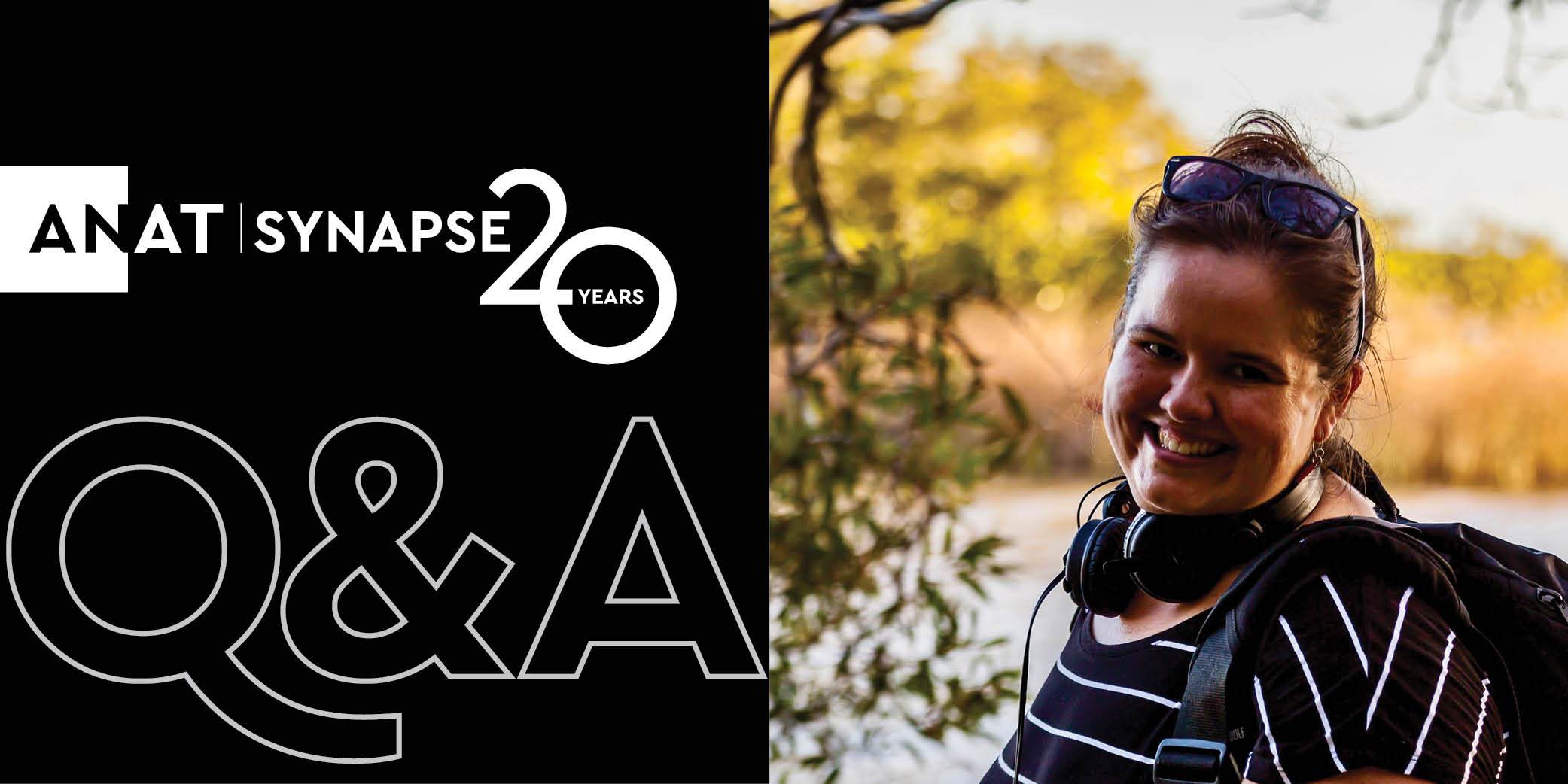
Leah Barclay headshot, courtesy of the artist.
Leah Barclay
Dr Leah Barclay is a sound artist, designer, and researcher who works at the intersection of art, science, and technology. Leah’s research and creative work investigates new methods in ecoacoustics, exploring the soundscapes of terrestrial and aquatic ecosystems to inform conservation, scientific research, and public engagement. She has been the recipient of numerous awards, and her work has been commissioned, performed, and exhibited to wide acclaim internationally by organisations including the Smithsonian Museum, UNESCO, Ear to the Earth, Streaming Museum, Al Gore’s Climate Reality, and the IUCN. Leah leads several research projects including Biosphere Soundscapes and River Listening, which focus on advancing the field of ecoacoustics. The design of these interdisciplinary projects is responsive to collaborating communities and involves the development of new technologies, including remote sensing devices for the rainforest canopy and hydrophone recording arrays in aquatic ecosystems. Leah is the Discipline Lead of Design at the University of the Sunshine Coast, where she is also co-leading the Creative Ecologies Research Cluster.
Can you tell us about your ANAT Synapse residency and where the research has led you?
In 2014, I was awarded an ANAT Synapse residency to work with the Australian Rivers Institute at Griffith University on a project called River Listening. The residency was designed to explore the creative possibilities of freshwater ecoacoustics (a relatively unknown field at the time) and set out with the ambition to develop new non-invasive approaches to the conservation of global river systems through sound. During the residency, I was fortunate to work with computational programmer Dr Toby Gifford and freshwater ecologist Dr Simon Linke, who is now a Senior Research Scientist and Freshwater Ecologist at CSIRO.
The residency itself was a whirlwind of ideas and experiments, with extensive fieldwork in river systems across Southeast Queensland, exploring new approaches to community engagement through interactive listening labs, field recordings, and sound maps. As there was such limited research around freshwater ecoacoustics, we were developing methods in the field, designing and developing new technologies for recording, and developing new processes that were deeply informed by both scientific and artistic approaches. The community engagement approaches and emerging models of reciprocity were the core of the fieldwork, this involved developing good relationships with Traditional Owners along the river systems, community groups, landholders, and even local farmers who had deep knowledge about the rivers (including warnings about crocodile locations in the Mary River, which resulted in quickly adapting the installation processes for our quadraphonic recording kayak!).
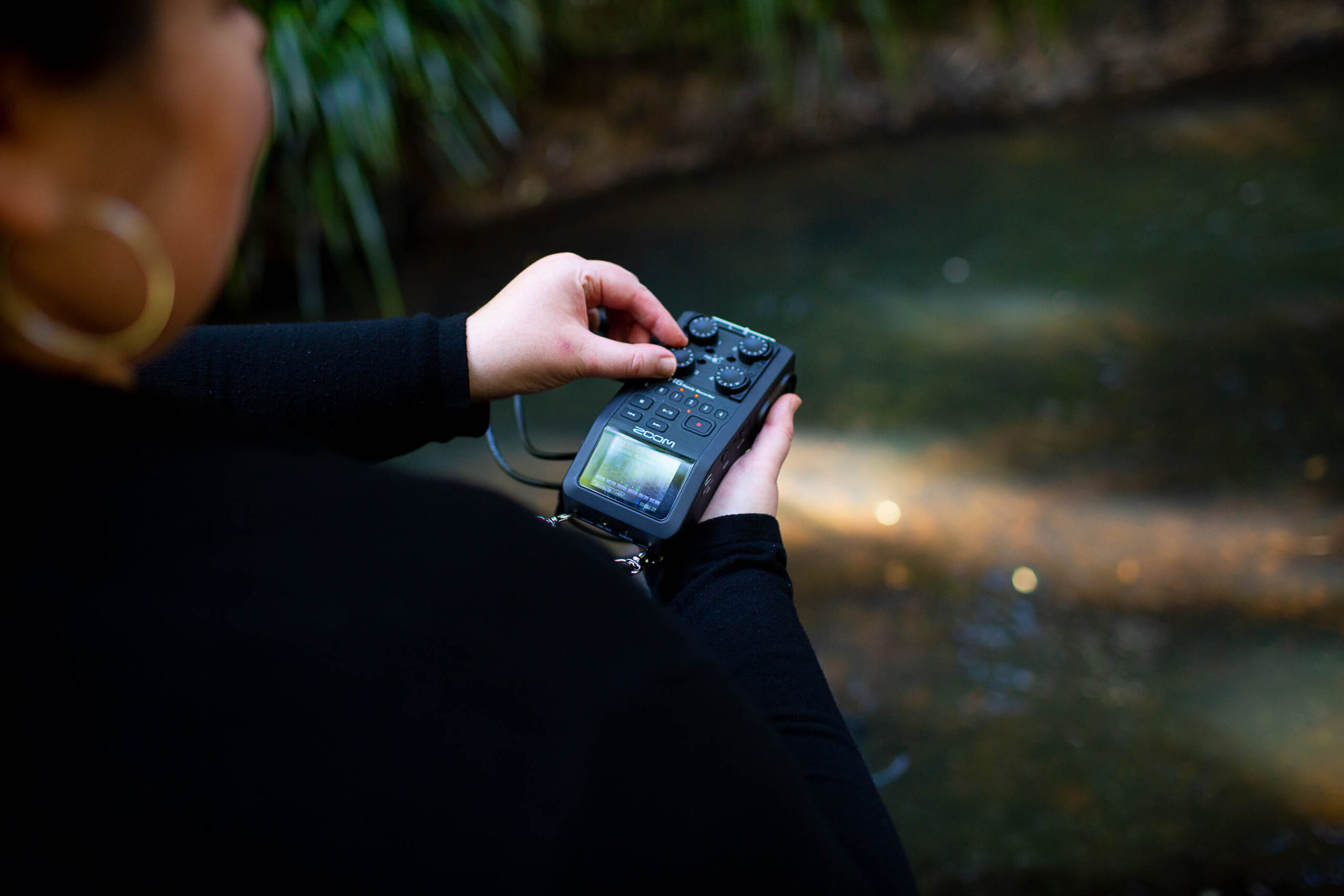
Hydrophone recording, photo by Tricia King.
River Listening really evolved to work at the intersection of art and science by investigating the cultural and biological diversity of freshwater ecosystems through real-time listening and underwater recording used for biodiversity monitoring and public engagement. We used non-invasive recording techniques with accessible hydrophone kits and participatory workshops to engage local communities in the process and outcomes. The resulting database of hydrophone recordings is used for ongoing scientific research and diverse creative projects worldwide. The artistic outcomes from River Listening are central to the project, these include augmented reality sound walks through mobile apps with soundscapes triggered by GPS along rivers as well as live-streaming hydrophone arrays. The soundscapes are accompanied by images and text identifying the sounds that are drawn from a local database of hydrophone recordings. Sounds could include community voices alongside local species of fish, aquatic insects, snapping shrimp, or any species that is endemic or invasive to the area. These artistic projects have assisted in the advancement of scientific recording techniques, ecoacoustic methods, and community knowledge about river systems. Alongside these artistic outcomes, we have all invested in writing and publishing the research outcomes along the way, with a focus on interdisciplinary processes. There is a paper in Leonardo during the ANAT Synapse residency that introduced the scientific possibilities, a special edition of Freshwater Ecology focusing on the science, and a more recent paper on River Listening in Freshwater Science that outlines the core outputs of the Synapse residency.
The ANAT Synapse process deeply influenced how I work as an artist, but also how I listen, how I design projects and research, and how I work within local communities. Throughout the process, I facilitated River Listening workshops in remote areas and major cities, ranging from capacity building on rivers in Cambodia with UNESCO to community workshops along the Los Angeles River in California. We took the project to Paris for COP21, connecting the rivers of the world in a live sound map and amplifying community voices who were absent from the meetings in Paris. Our accommodation was cancelled at the last minute and so were our hydrophone installation permits (due to terrorism threats), but we managed to Airbnb a houseboat on the Seine and had the River Listening hydrophones out our bedroom windows, which was a pretty memorable experience. There was a lot of positive energy at COP21, and it was a privilege to share the project in the context of that meeting. I was invited to give a keynote on the project at the UK Sound and Environment conference and an installation and workshop as part of the Hull UK City of Culture 2017, the biggest outcomes from these experiences were the importance of creating accessible pathways for young people to engage with River Listening. One of the Hull workshops was on a freezing cold day with torrential rain, yet we still had groups of enthusiastic children enthralled by hydrophones and asking their parents for hydrophones for Christmas.
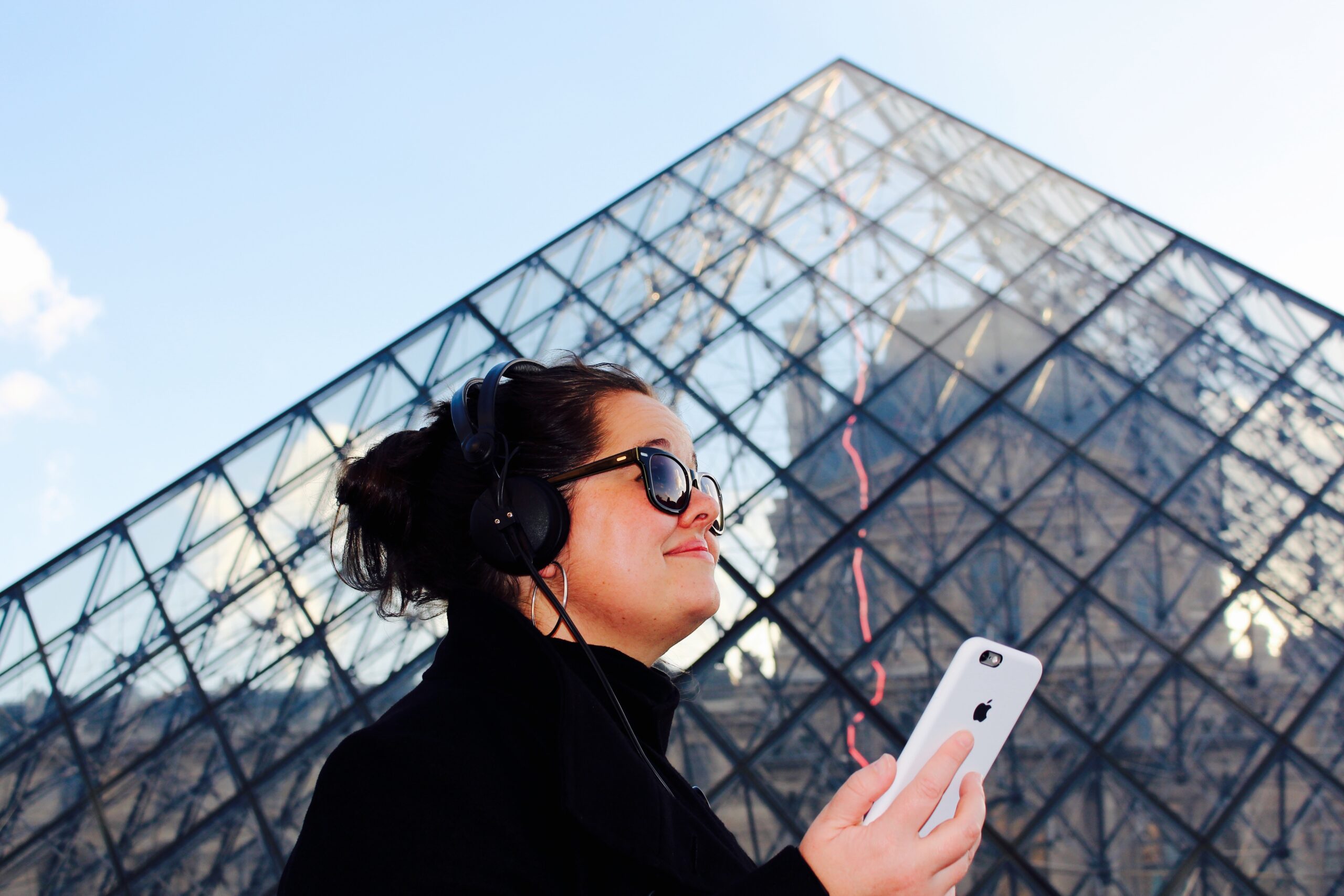
River Listening sound walks, COP21, Paris 2015, Toby Gifford.
This investment in education and capacity building during and after the residencies has been so important in expanding the work. I’ve delivered seminars on the research alongside installations and performances. I also held guest appointments at New York University, teaching in the music technology program around acoustic ecology and the use of hydrophones in 2014–2015, which involved a River Listening collaboration with Annea Lockwood on the Hudson River, who has been a huge inspiration for the project. Also, a postdoc at Griffith University and a visiting position at Arizona State University, where the River Listening installation resulting from the Synapse premiered at the ASU Art Museum as a multi-channel sound installation. The project was also presented at the World Parks Congress, World Conservation Congress, and International Ecoacoustics Congress, along with various other community events and projects.
Now in 2024, freshwater ecoacoustics is gradually becoming respected as a scientific discipline, and there are artists all around the world recording rivers and monitoring river health, there are like-minded interdisciplinary projects receiving major support and funding at international universities, and community projects across the world, it’s really inspiring to see this increase in engagement. The Australian Ecoacoustics Congress that just happened in Melbourne showed just how far this discipline has come in a short period of time, and the World Ecoacoustics Congress coming up in Spain has streams focused around freshwater ecoacoustics. We’ve presented outcomes at both ANAT SPECTRA 2018 as well as ANAT SPECTRA: Multiplicity 2022, and the ANAT Synapse opportunity was without doubt a pivotal moment in my career. Another important outcome is the people involved, I’ve worked with Simon and Toby since the residency, and they’ll likely be lifelong friends and collaborators thanks to ANAT Synapse. We’ve had fantastic opportunities to work with so many amazing scientists, artists and community leaders along the way, and I think good collaborators make all the difference in interdisciplinary practice – people you trust who are driven by the same curiosity, and working with the same integrity and passion to improve how we live and interact on this planet, all while recognising the value of interdisciplinary practice in addressing some of the greatest challenges we have in the world today.
What is the biggest challenge of being an interdisciplinary artist?
I think one of the biggest challenges for experimental interdisciplinary art, especially working in remote or regional areas, is building respect and understanding of the practice. There can often be scepticism amongst traditional scientists, and apprehension and uncertainty amongst the community, but I have always found these challenges can be navigated by building relationships, sharing the work in an accessible way, and giving the project the time it needs to unfold in the right way. These tensions can also be challenging when negotiating funding, partnerships, and support for interdisciplinary work, and the need to shape projects in different contexts without compromising the integrity of the work. We have definitely reached a point where there is respect and understanding of art-science practice, with Australia really leading the way in many areas, but there is still a significant amount of advocacy needed in many contexts which can still be challenging.
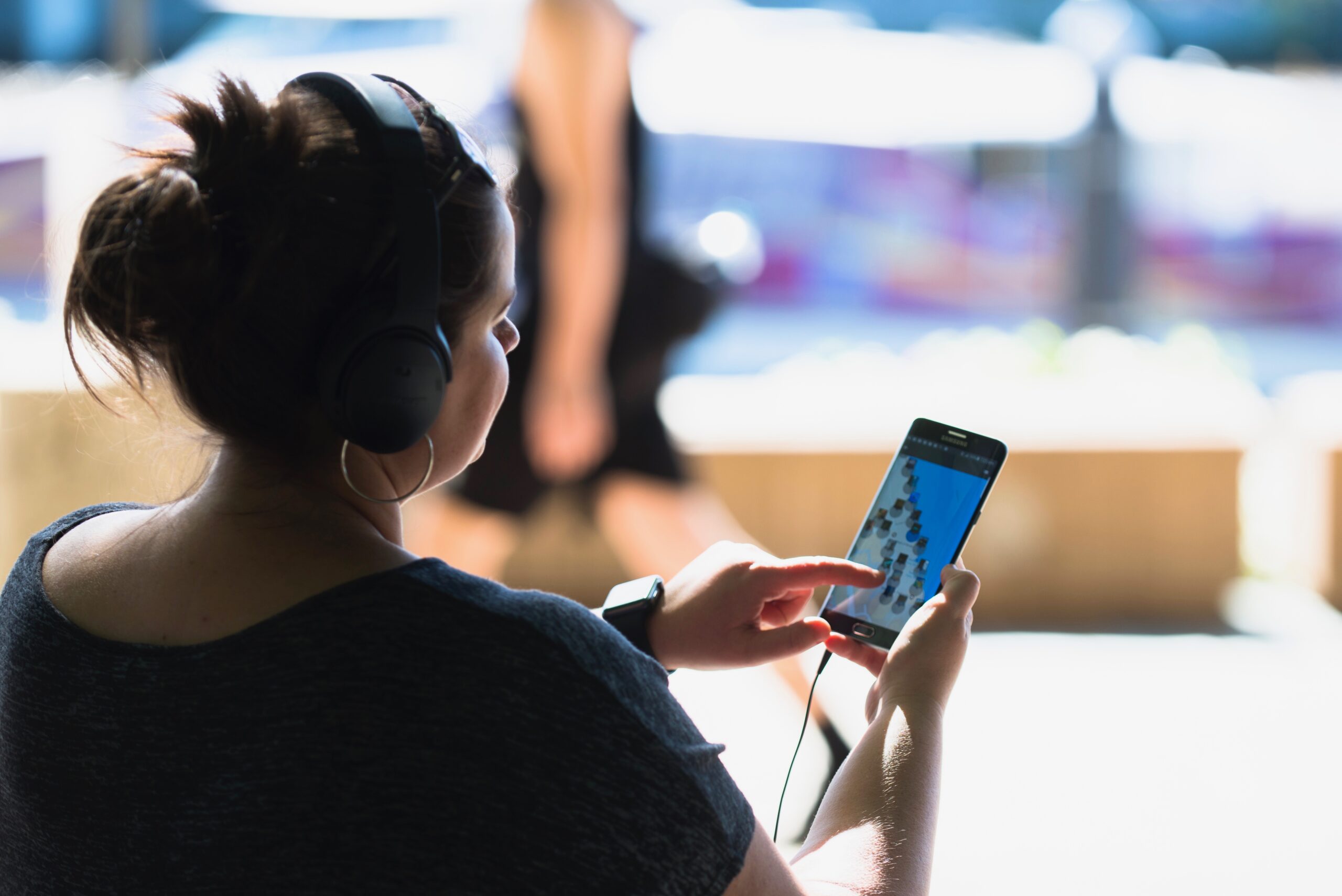
River Listening sound walks.
Personally, the biggest challenge for me in interdisciplinary practice is managing time and balancing the various roles within a project. Interdisciplinary artists are often also creative producers and project managers, and I’ve always had models of reciprocity built into the design of projects. This has often meant working on things far beyond the scope of the project within local communities in different parts of the world and really investing time and care in these relationships over time, which I feel is an integral part of my practice and something I’m always committed to. I feel very privileged to have had many opportunities as an artist, but I’ve become much more pragmatic about the kind of projects I’m engaging with and the organisations I work with. There are ethical reasons for that around how the project might be funded, the carbon impact of international travel, or how the project is extending practice in an ethical way, but there have also been practicalities in the last few years with COVID-19. Being immunocompromised with a chronic illness has meant a halt to international travel, and while I travelled constantly for over 10 years for projects, this shift in how I work actually allowed me to reposition my practice back in Southeast Queensland, where the River Listening project started in 2014, which has been a positive experience in refocusing. It can be difficult managing international engagement as an Australian artist, as there is certainly an expectation to remain visible and present in the international arts community, but hopefully, this expectation will continue to shift with more awareness and responsibility around the carbon impacts of travel and opportunities expanding in virtual environments.
I find the time management factor challenging as well with the practice I’m engaged with that focuses on climate action and responding to ecological crises. There is a paralysing sense of urgency with horrific things happening in parts of the world that demand time and support, and this can come with a sense of guilt, where I find investing time in creative works can sometimes feel indulgent where activism and direct action may seem more effective and reactive. But I truly believe interdisciplinary creative practice and embodied experiences are one of the most powerful ways to create the shift in thinking that is so urgently required. There is ample evidence this is possible with incredible creative projects across the planet, and I feel a project like River Listening (while at a small scale) is an example of how we can create a ripple effect across arts and sciences, that is gradually improving approaches to freshwater conservation and inspiring communities to directly engage in the process. These challenges around managing time also mean I’m much more realistic about what is actually possible with creative work, ensuring the work is shared in an ethical and accessible way and having a beneficial and meaningful impact on the community.
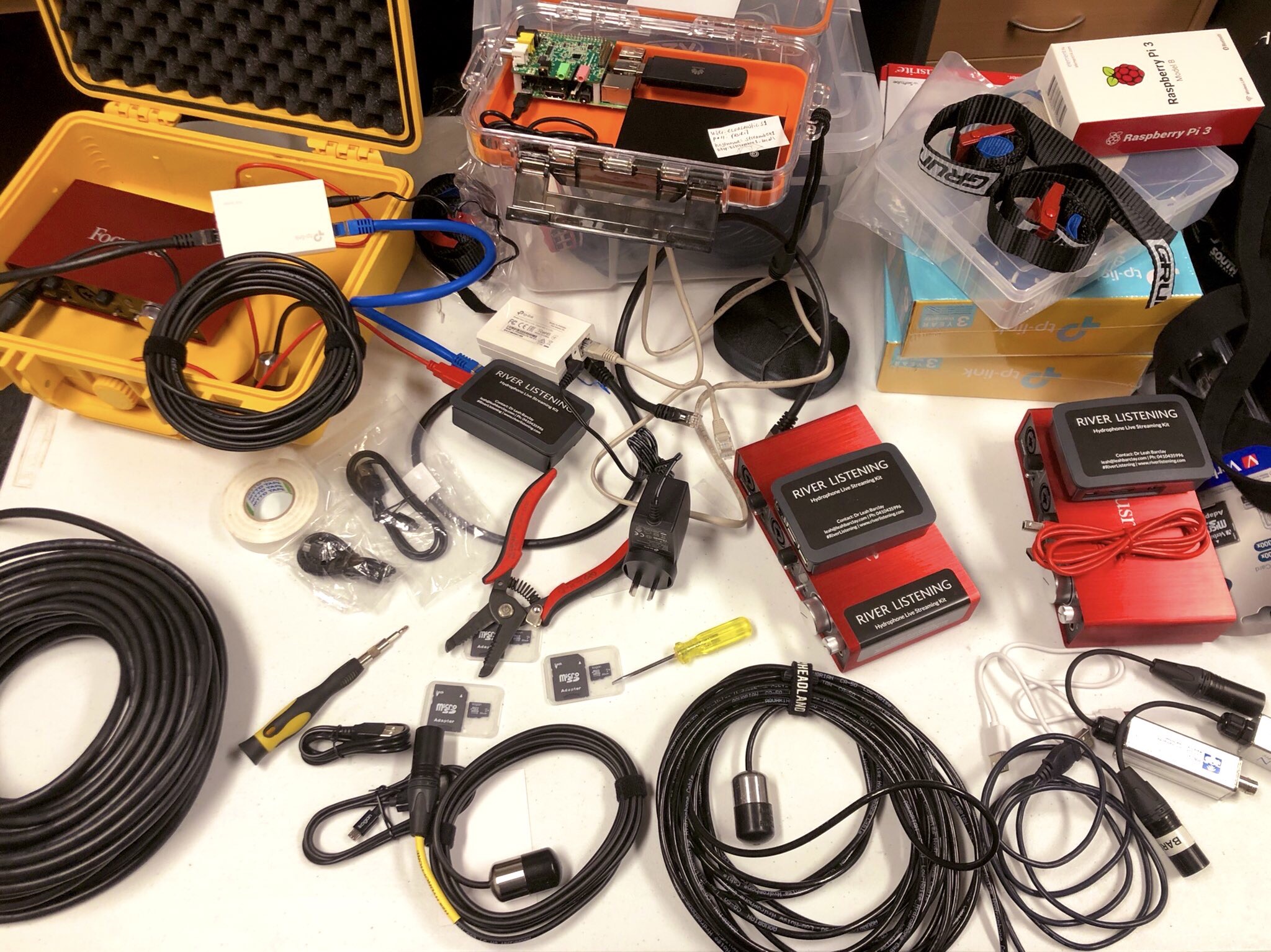
Building River Listening live streaming kits.
In terms of my specific practice, interdisciplinary sound art and design, grounded in environmental field recording, it can be a challenge to navigate the historical foundations of the field and ensure my approaches are always as ethical as possible. Western field recording practices are still associated with extraction and exoticism, and I’ve always been very conscious not to fall into this territory, though I know some of my very early work does. Creative and scientific field recording approaches can also differ in the field, but critical considerations for me have always been around consent, collaboration, and permission. All the River Listening locations have evolved through relationships within the local community, deep listening onsite, invitations to record, and collaborations in the outcomes. River Listening really became a model to look at more ethical ways of recording in the field, and sharing the resulting recordings, with reciprocity, collaboration, and co-design at the core of how those models evolved.
As a non-Indigenous artist, it was critical for me to have permission to record, foster relationships with Traditional Owners along the river systems, and ensure we were adopting anti-colonial approaches at each step. An important part of this was also respecting advice and guidance around recording locations and stopping immediately if advised. Part of this has also been recognising that we are always learning, and these projects and processes are always evolving. I see the resulting creative works as living and evolving too, collaborative outcomes with place and community, which is why augmented reality experiences where the soundscapes are responsive to the site became the most important outcomes from River Listening. Early in my career, I moved away from releasing albums of my sound work through most projects, as fixed media didn’t feel like an authentic way for work that was so deeply connected to place (and often involving live streams and responsive spatial audio). That has perhaps meant that my work isn’t as accessible as it could be and results in some contradictions in my practice that seeks to be accessible and inclusive, but I always invest in multi-platform ways to share the work from the field, including accessible live streams, sound maps, and virtual outcomes.
What kind of mentor-mentee relationships have you experienced throughout your years of practice? Is there any particular mentor or mentee that stood out for you?
I was lucky to meet and work with Ros Bandt early in my career and see her as an incredible pioneer of experimental interdisciplinary practice in Australia, and still consider her a mentor today, offering generous advice and support, and someone who is always giving back to the sector. I spent many years working with the environmental sound art organisation Ear to the Earth in New York City, and was very privileged to be mentored by Joel Chadabe, Nora Farrell, and Bill Duckworth during my time in New York. They are all sadly no longer with us, but I will never forget their generosity, the opportunities they provided for me, and the ways they operated in the international arts community, always innovating, always sharing, and despite having incredible artistic careers in their own right, always investing time in supporting the development of the field, giving back and advocating for others.
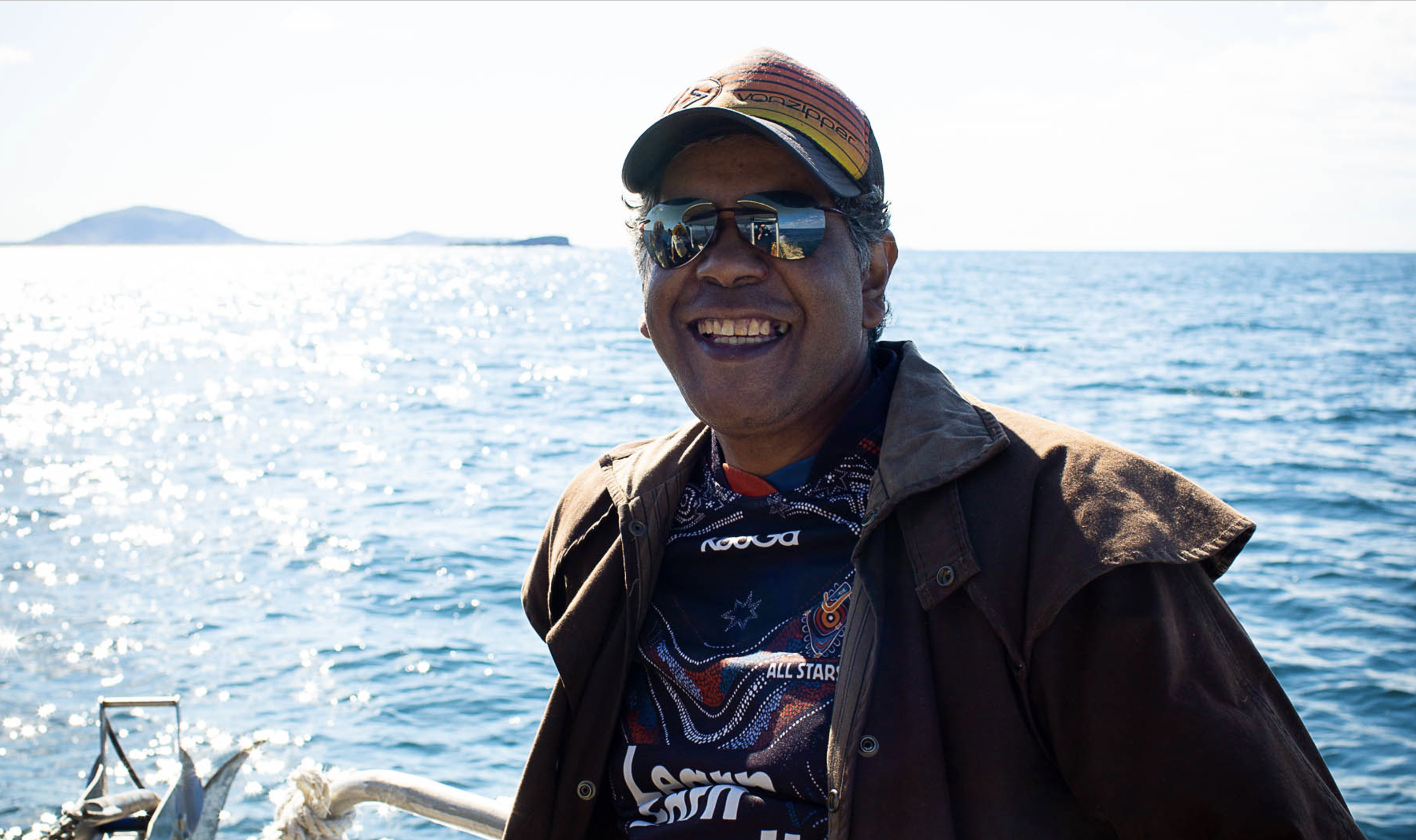
Lyndon Davis on Kabi Kabi Sea Country, photo by Tricia King.
I feel very privileged to have long-term collaborations with First Nations artists through projects such as River Listening and Biosphere Soundscapes and consider them important mentors who I’m constantly learning from. I currently live and work on Kabi Kabi Country and have worked with Kabi Kabi artist Lyndon Davis for over 15 years now, and I feel like our collaborations have been mutually beneficial in that I’ve learnt so much from Lyndon, and he’s now become deeply engaged in art science practice and doing fascinating work with sound and emerging technologies. Mentors within the sector have also been very important, the team in Emerging and Experimental at Creative Australia and organisations such as ANAT. I wouldn’t be where I am today without the support of ANAT, and that’s not just through programs like ANAT Synapse, that’s through the support and generosity of the incredible ANAT team, the ANAT network of artists and scientists, the connections, and events such as ANAT SPECTRA being pillars to connect the sector, share ideas, showcase projects, and foster collaborations and connections.
I’m also really grateful to have acted as a mentor for various artists in Australia and to have supported early-career artists during professional development programs. It is nice to see there are a lot more hydrophones out and about in Australia and a lot more artists exploring different sonic approaches in their practices. I feel as someone who has benefited from opportunities and generous support from my colleagues and mentors throughout my career, I have a responsibility to give back, but it’s also something I really enjoy, especially the process of teaching, working with Masters and PhD students, and mentoring emerging artists. It all feels like an integral part of a creative practice based around care and reciprocity, and I’m always inspired by the process.
As an interdisciplinary artist, who and what are your biggest influences?
I’m influenced by place, by the ecosystems and environments around me, the sense of urgency to respond to the rapid rate of extinction and improve the current systems and ways of living that urgently need to change. That sense of urgency is tempered by an awareness that these processes take time, that impact happens over long periods, and meaningful relationships with places and people require trust, time, and reciprocity. As much as the current state of the planet in many ways is horrific and overwhelming, I’m inspired and influenced by the glimmers of hope, the scientific discoveries being made every day that improve our understanding and care of the natural world, and the expanded possibilities enabled by emerging technologies. The next generation is also a big influence on how I design projects, and I’ve always been committed to creating accessible pathways for young people to engage with art science practice. I’m lucky to be involved in a program called Kids in Action on the Sunshine Coast, which brings artists and scientists together and aims to grow a culture that values caring for the natural world, with children leading the projects and ideas. This includes 15-year-old Taylor Ladd-Hudson advocating for the removal of unnecessary shark nets and 12-year-old Spencer Hitchens showcasing his photography to protect habitat for critically endangered Glossy Black Cockatoos.
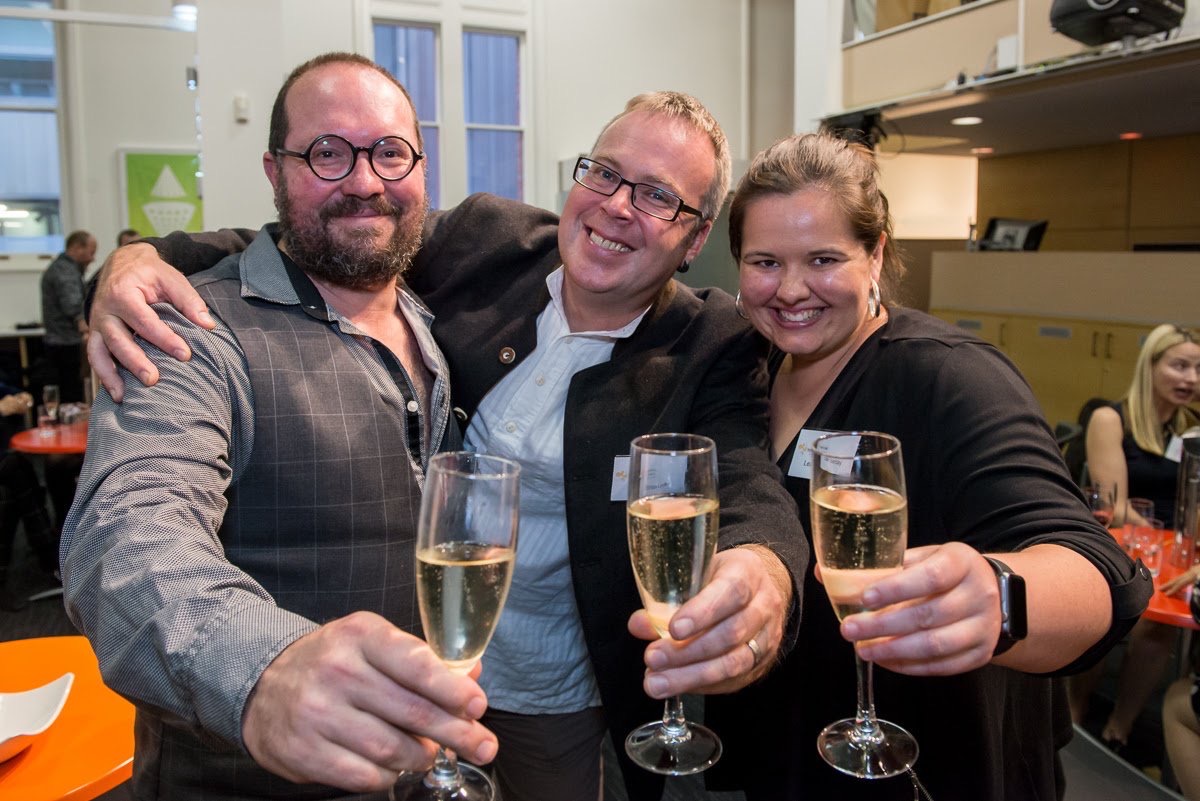
River Listening team, Dr Toby Gifford, Dr Simon Linke and Dr Leah Barclay, ANAT Synapse event.
I’m inspired and influenced by the incredible community of art science practitioners in Australia, including people like Leila Jeffreys, Vanessa Tomlinson, Helen Pynor and Philip Samartzis, and also the inspiring work expanding internationally with artists such as AM Kanngieser, and their powerful Oceanic Refractions project. I’m constantly inspired and influenced by artists who do important work with ethics and integrity. Interdisciplinary sound artists such as Annea Lockwood, Ros Bandt, and Jana Winderen continue to be an influence. Likewise, I’m influenced by the scientists I’m currently working with including Monica Gagliano on plant bioacoustics and Olaf Meynecke around marine ecoacoustics. The biggest influence for me, though, is still place and people, the rate of change and extinction, the urgency to act, inspire others to act, and to do so through listening, care, and collaboration.
What are you working on at the moment?
I’m currently the Discipline Lead of Design at the University of the Sunshine Coast (UniSC), and while that absorbs a significant amount of time and I know some artist-academics hide their academic positions at the bottom of their CV, this is a huge part of what I’m doing at the moment and I’m really proud of what we are creating at UniSC. We have redeveloped the design program in the last couple of years to have a place-based interdisciplinary focus, and I’m really inspired by the team we are building and the incredible students who are coming through the program. Our campus is Land for Wildlife, we are in the centre of UNESCO’s recognised Sunshine Coast Biosphere Reserve, and the only region in the world with three connected coastal Biosphere Reserves, including the Great Sandy Biosphere Reserve, with UNESCO World Heritage island K’gari in the centre, which is home to UniSC’s international K’gari Field Station where I’m currently working on multiple projects. We’ve also recently launched the Creative Ecologies Research Cluster, which explores how interdisciplinary creative practice can have a meaningful impact on local and global communities, and we have so many exciting projects and partnerships in development. The cluster works at the intersection of art and science, with a focus on health and well-being, emerging technologies, ecological engagement, and regenerative design. We have a body of work focusing on arts health with older adults led by Tricia King and some exciting partnerships in XR which will see VR work with manta rays and turtles launching soon. We’re committed to culturally sensitive methodologies that respect Indigenous protocols under the guidance of a First Nations Advisory Group, with a governance model designed around ecological reciprocity. We are hosting a Fieldtrip to UniSC as part of ISEA2024 coming up in June, this will involve a bus to the Sunshine Coast with a Welcome to Country with Lyndon Davis, ocean expeditions, performances, and immersive experiences, including a major ISEA2024 exhibition opening at the UniSC Art Gallery. We’re hosting a panel with ANAT celebrating the 20th Anniversary of Synapse as part of the Fieldtrip and floor talks with artists in the UniSC Art Gallery.
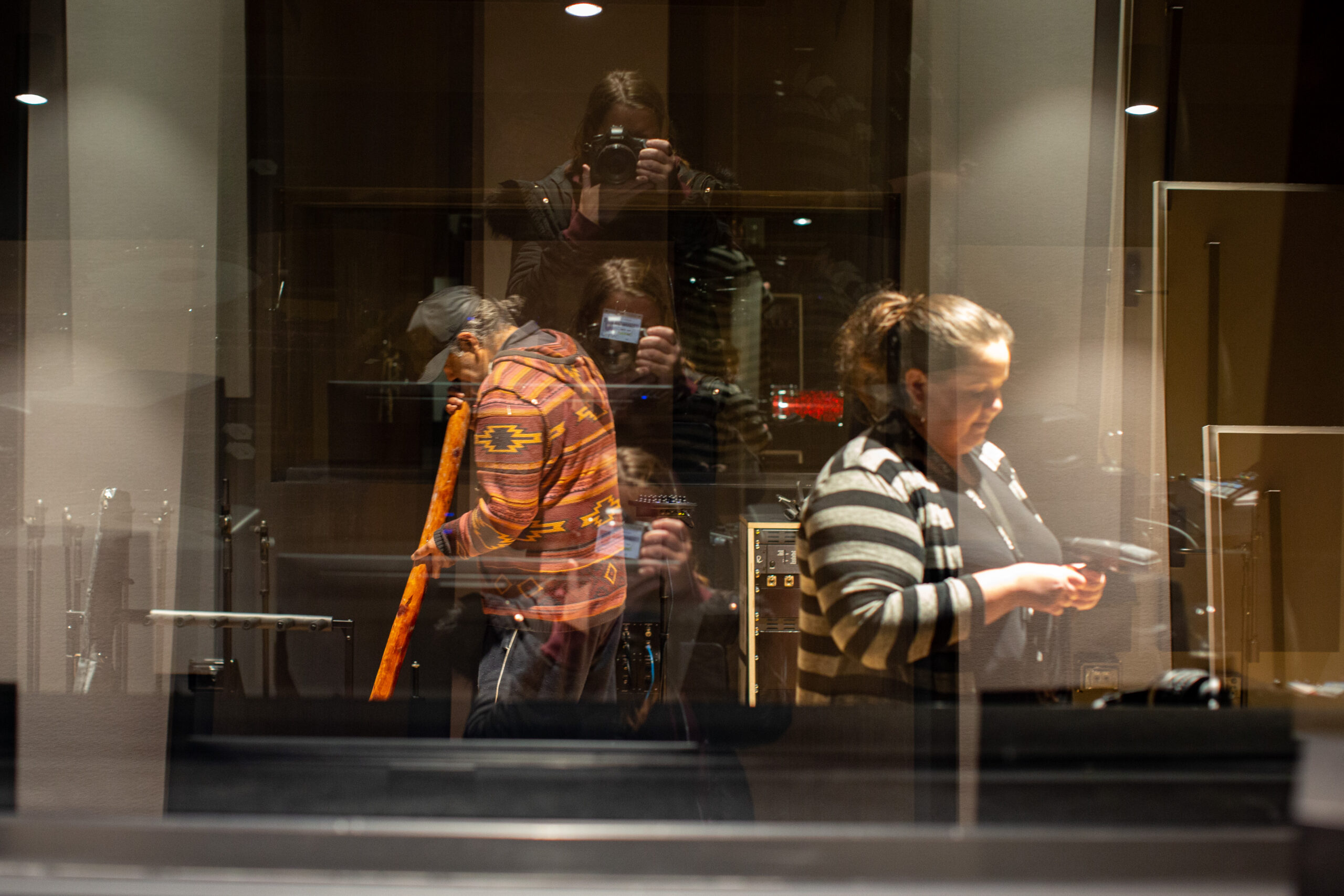
Beeyali project, photo by Tricia King.
I’m working on a series of ongoing collaborations with Lyndon Davis and Tricia King through the Beeyali project, which was supported through ANAT’s New Light 2021 and more recently through a Creative Australia grant to extend the work. Beeyali is a Kabi Kabi word meaning “to call” and acts as a call to listen – an alarm for the multitude of vulnerable species on the brink of extinction in Australia. We recently extended from a focus on birds to explore marine ecosystems on Kabi Kabi Sea Country, with Tallo Billa (humpback whale), a new work that involved a dusk performance with live hydrophones in the ocean, mixed into an immersive soundscape with cymatic visualisations of humpback whale song, projected live over Old Woman Island. The audience boarded Sunreef’s Whale One for an augmented reality experience at sunset, followed by a Welcome to Country with Lyndon Davis over the ocean before the performance. Tallo Billa utilises original Beeyali visualising techniques, playing underwater soundscapes through digital images to create distinctive audio-visual portraits with generative visualisations activated by hydrophones. This work will continue expanding in 2024, with field trips and immersive experiences, including a Tallo Billa immersive listening expedition underwater. I absolutely love working with Lyndon and Tricia on this project, and there have been such amazing moments of serendipity and synchronicity throughout the fieldwork, that have made us all realise this is a very special project we’ll be working on for many years to come.
I’m also currently working on a series of new installations for Biosphere Soundscapes live audio streams in Southeast Queensland, with a focus on rivers, rainforests, and reefs in UNESCO biosphere reserves. These streams are part of the BIOM project (Biosphere Open Microphones) looking at the art and science of listening to live audio from remote locations and developed in collaboration with Biosphere Soundscapes (AU), SoundCamp (UK), and Locus Sonus (France). The new streams are timed to launch with the 11th edition of the Reveil broadcast, which will take place on International Dawn Chorus Day, over the first weekend in May 2024. Reveil is a collaborative sound and radio project that circles the Earth on live audio streams at daybreak, following the soundscapes of dawn across the planet and offering this unique perspective into a 24-hour continuous live soundscape following sunrise around the earth. It’s broadcast on radio stations around the world and streams live online. I’ll be mixing the Asia-Pacific region from the Sunshine Coast Biosphere Reserve alongside the new streams. Reveil is an inspiring global sound project and always done in an ethical way, you can listen live from anywhere in the world and there are still pathways to collaborate, and we always welcome new collaborators into the network at soundtent.org/reveil
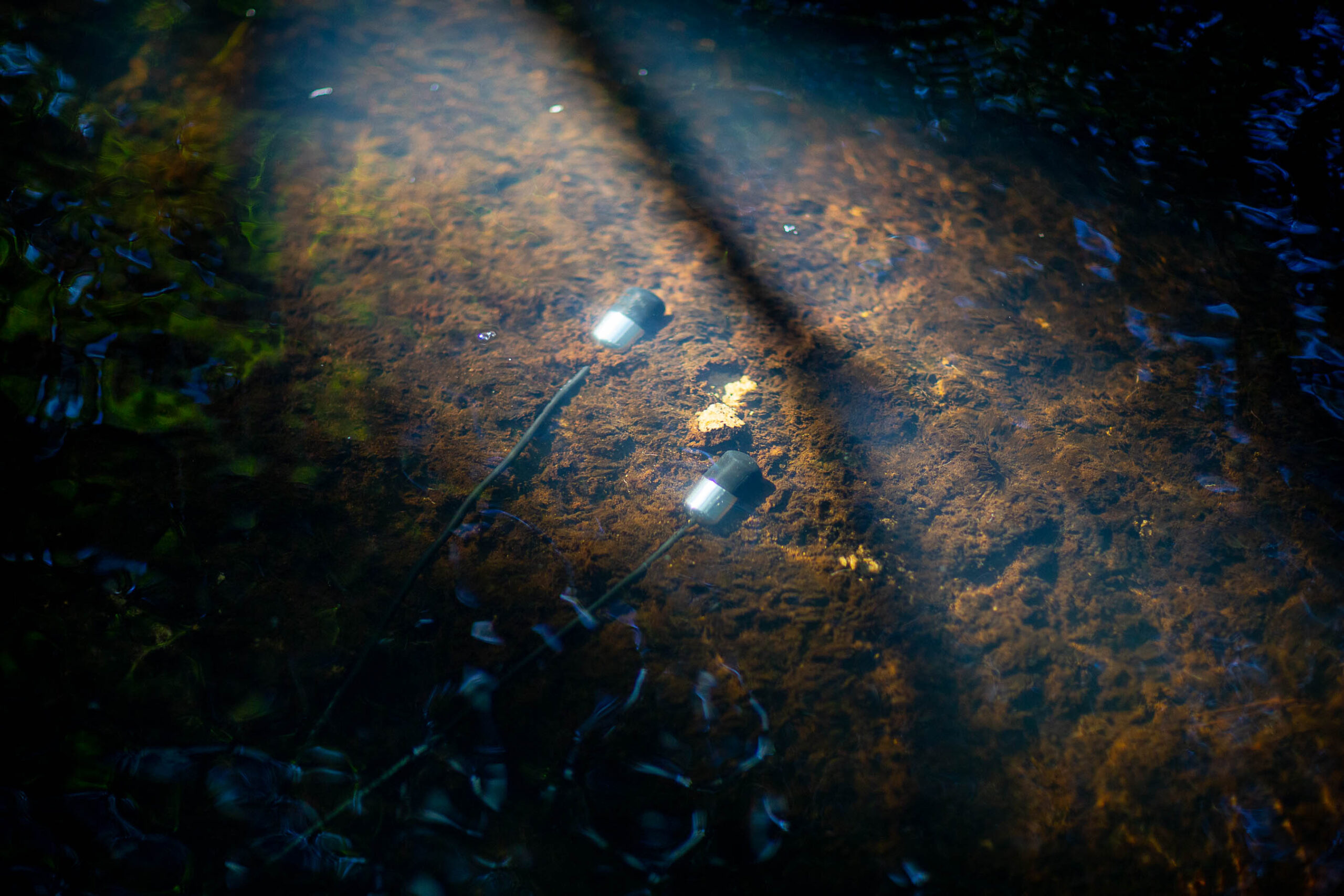
Hydrophones in the river, photo by Tricia King.
Finally, it’s a big year ahead for River Listening! It’s exciting to see how far we have come since the residency. It’s been exactly 10 years since we started the project through Synapse, and we’re excited to be launching a major new work for ISEA2024 in Brisbane. We’ll have sonic kayak tours, live hydrophones in the Brisbane River (from Toby’s new boat!), sound walks along the Brisbane River running for the duration of ISEA, and a new app and website (www.riverlistening.com.au). When the first River Listening experiments launched in the Brisbane River as part of the residency in 2014, Toby and Simon had hydrophones live in the river, and I was mixing them into a multi-channel performance in New York as part of World Water Day, so it has been exciting to reflect on how far the project has come over the last decade, and the impact the project has had within various communities. It is also inspiring to see the vision for the work hasn’t really changed. I’m still trying to do exactly the same things I wrote in the Synapse application 10 years ago “developing accessible community engagement around the creative and scientific possibilities of connecting to place through emerging technologies to improve the health and well-being of people and places, and inspiring communities to engage with sound practices at a time where it is increasingly important to listen to the environment.”
So, lots of exciting things on the go, and I certainly welcome the ANAT community to join us on some River Listening expeditions and the Sunshine Coast Fieldtrip during ISEA2024!